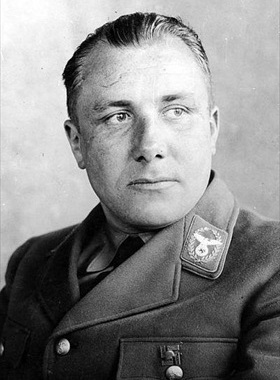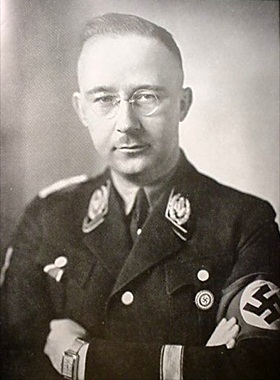GERMANS MUST CHOOSE VICTORY OR DEATH
Berlin, Germany • April 2, 1945
In the spring of 1945 senior leaders of the Third Reich were growing panicky. In the west, American troops had succeeded in crossing the Rhine River at Remagen 35 miles/56 kilometers south of Cologne on March 7 and were advancing into the German heartland. In the east, the tracks of Soviet mechanized armor and the boots of their infantry could be heard approaching the outskirts of the epicenter of Nazism, Berlin.
On this date, April 2, 1945, the Nazi leadership made desperate calls on the shrinking population still under its control. Martin Bormann, short, dark, ruthless head of Adolf Hitler’s Nazi Party Chancellery and, as Hitler’s “shadow” the Fuehrer’s primary connection with the outside world, now called on his countrymen to make a last-ditch stand against the Allied invaders. The hour admitted of only one slogan: “Victory or death.”
Already engaged in sending out peace feelers to the Allies behind his Fuehrer’s back, duplicitous Reichsfuehrer-SS Heinrich Himmler, chief of the secret police and lead engineer of the “Final Solution” (the Nazi plan for the extermination of European Jewry), decreed that severe measures would be taken against those hanging white sheets off their balconies or out their windows. All male inhabitants of a house displaying a white sheet would be shot. Anyone refusing to serve in the Volkssturm (a home guard of mostly child soldiers and World War I veterans who were under the direct control of the Nazi Party except in combat), or caught removing tank barriers in the streets, or was otherwise believed to be imperiling the Fatherland would be severely dealt with. The Nazi Gauleiter (provincial governor) of Berlin, Joseph Goebbels, who also was Hitler’s Minister of Public Enlightenment and Propaganda, spelled out the severity for shirking one’s duty to defend the Reich capital, plastering notices on front doors of every house: “On orders from the Fuehrer . . . all men between the ages of 15 and 70” had to report for military service, no exceptions. “Any coward who slips away into the air-raid shelters . . . will be court-martialed and put to death” (quoted in Joachim Fest, Inside Hitler’s Bunker: The Last Days of the Third Reich, 28–29).
On the same date, April 2, 1945, round-the-clock work on a vast new Fuehrerbunker southeast of Weimar near the Ohrdruf slave labor camp in Thueringen (Thuringia), Eastern Germany ended when 9,000 inmates were forced-marched to the parent Buchenwald death camp 32 miles/51 kilometers away. It was from this still unfinished headquarters in the hills around Ohrdruf that Hitler and other Nazi stalwarts hoped to strike a deal with the Western Allies to join the remnants of the Wehrmacht (German armed forces) in fighting the “Jewish-Bolshevik” Soviet Union.
When covert initiatives such as Himmler’s peace feeler surfaced in Western capitals (Reuters and Britain’s BBC news services leaked Himmler’s test balloon in news reports), they were rejected out of hand. For the Western Allies, coming to terms with Nazi Germany demanded unconditional military surrender, not a negotiated armistice in the style of World War I or updating the Nazi-era anti-Cominterm (anti-Soviet) Pact. In a rapid series of unconditional surrenders, beginning at Lueneburg Heath, near Hamburg, Northern Germany, on May 4 and ending on May 8, 1945, in the former Nazi capital of Berlin, the beaten German military did just that.
Martin Bormann and Heinrich Himmler: The Two Most Powerful Men in Nazi Germany After Adolf Hitler
 |  |
Left: Martin Bormann (1900–1945), Chief of the Party Chancellery (Parteikanzlei, May 12, 1941, to May 2, 1945) and private secretary to Adolf Hitler. By using his all-powerful position to control the flow of information and access to Hitler (his nickname was “His Brown Eminence”), Bormann earned many enemies, including Heinrich Himmler. (Like Himmler, Armaments and War Production Minister Albert Speer (pronounced “spare”) took a dislike to Bormann, privately referring to him as “the man with the hedge clippers,” because of Bormann’s predilection for eliminating anyone rising above a certain level in Hitler’s coterie, as Speer had done.) After Hitler’s suicide, Bormann left the Fuehrerbunker, where he was a boarder, on May 1, 1945. According to one authority Bormann had been entrusted by Hitler with several orders to be delivered in person to his successor as German head of state, Adm. Karl Doenitz, now sheltered in Flensburg near the Danish border. In attempting to avoid falling into Soviet hands, Bormann likely committed suicide near the site of today’s Berlin Hauptbahnhof. A fellow bunker escapee claimed to have clearly seen Bormann’s body in the moonlight. Bormann’s remains were never recovered by the Soviets, though not for want of trying. In December 1972 construction workers in West Berlin uncovered a decomposed body with a cyanide capsule in its jaw; soon thereafter the remains were forensically confirmed as Bormann’s. Genetic testing later conclusively confirmed the identity of those remains.
![]()
Right: Heinrich Himmler (1900–1945), Reichsfuehrer of the Schutzstaffel (SS). From 1943 onward Himmler was both Chief of German Police and Minister of the Interior, overseeing all internal and external police and security forces, including the Gestapo (Secret State Police). On account of his decades-long loyalty and sycophancy, Hitler referred to Himmler as “the faithful Heinrich” (der treue Heinrich). On the other hand, Reichspraesident Doenitz thoroughly distrusted Himmler and stripped him of all authority in his new administration. Disguised in shabby civilian clothing and with a new identity, the Nazi fugitive was captured by a British military patrol and, hours later, during his examination by a medical doctor bit into a hidden cyanide capsule and died within minutes on May 23, 1945. Three days later the body of the rogue Nazi bigwig was buried in an unmarked grave someplace in Lueneburg Heath, Lower Saxony.
Martin Bormann, Head of the Nazi Party Chancellery and Private Secretary to Adolf Hitler (Skip first 40 seconds)
![]()

 History buffs, there is good news! The Daily Chronicles of World War II is now available as an ebook for $4.99 on Amazon.com. Containing a year’s worth of dated entries from this website, the ebook brings the story of this tumultuous era to life in a compelling, authoritative, and succinct manner. Featuring inventive navigation aids, the ebook enables readers to instantly move forward or backward by month and date to different dated entries. Simple and elegant! Click
History buffs, there is good news! The Daily Chronicles of World War II is now available as an ebook for $4.99 on Amazon.com. Containing a year’s worth of dated entries from this website, the ebook brings the story of this tumultuous era to life in a compelling, authoritative, and succinct manner. Featuring inventive navigation aids, the ebook enables readers to instantly move forward or backward by month and date to different dated entries. Simple and elegant! Click 











